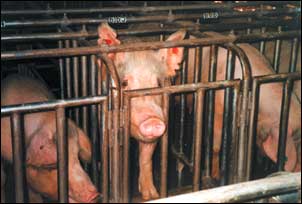This Little Piggy Creates Waste
Now imagine the combined power of thousands of piggies packed into a single building, with each swine producing 10 pounds of waste per day. Confined animal feeding operations (CAFOs) are becoming a horrifically polluting hallmark of competitive agriculture.

Waste from the pigs is washed out into large holding ponds, called lagoons. A three-acre waste lagoon from a typical CAFO can leak up to a million gallons a year, according to the North Carolina-based Hog Watch, a project of Environmental Defense. Lagoon waste is also sprayed on fields, where rain can wash it into adjoining water supplies. Because dust and gasses from hog farms can travel up to two miles, neighbors often complain of respiratory problems.
Plans for a massive hog production plant in Eastern Idaho were narrowly defeated last fall, after a yearlong struggle between hog boosters and local environmental groups. The Jefferson County Planning and Zoning Board, in a close six-to-five vote, denied a request by farmer David Robison to build a 100,000-hog facility near the town of Roberts. Robison, who farms 5,000 acres, had offered the latest in a series of proposals for area hog production facilities.
“This facility will provide good paying jobs with health benefits and pay $150,000 a year in property taxes,” promised Robison, who during testimony at a heated board meeting held up a jar of bull testicles and claimed someone put them on his doorstep with a threatening note. Robison added that the tax money “will be a shot in the arm for our farm economy.”
Lianne Buxton, president of the Jefferson County Coalition for Clean Air and Water, led the opposition. “Almost no one favored the hog facilities, except a few large landowners wanting to sell out to corporate hog producers,” she argues. “These landowners are in bad shape because of several years of poor crop prices.” The Jefferson County complex, which would have included a slaughterhouse and grain mill, was slated to produce a million hogs per year.
“A few of us got together and were able to stop this environmental nightmare,” says Denise Cooley, a Coalition member. “At the beginning we had no political experience and the hog people appeared to be invincible. But soon the whole county was involved, so we got a lot of help. Our neighbors were glad we took a stand.”

